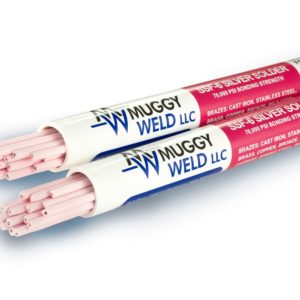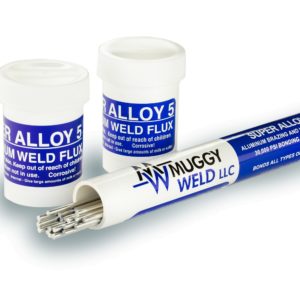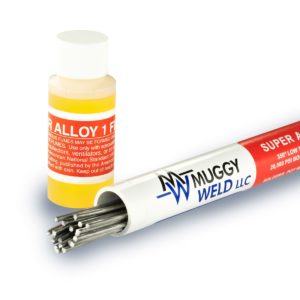Ever wonder how to weld cast iron without the cast iron re-cracking? At Muggy Weld, we’ve got your answer.
This 1989 Continental Diesel Cast Iron Engine Block with a sizable hole punched through from a rod was welded with MuggyWeld 77 cast iron weld rods. Our customer used TIG welding for this motor, but many cast iron engines have been repaired using arc or stick, even with an old buzzbox.
These engines are found in Miller Big 40D welders and Case Skid Steers. Cory broke the flux off the stick and cleaned the wire with scotch brite before welding. (some welders choose to leave the flux coating on when TIG welding)
The cast iron was sanded or ground down just to make sure there was no debris, grease etc. that could’ve been trapped in the pores of the weld area. Small tack welds were used. The broken cast iron pieces were TIG welded using a 2% Thoriated Tungsten and Argon Gas. Cory tack welded the whole piece (mounting base) into the block.
Tack welding is an important step as it holds the part in proper alignment until the final welds are made. Essentially, Cory drilled holes at each end of the crack, then added small deposits of the cast iron filler rod incrementally to hold the joint in place. Cory also pre heated the cast iron with a torch and post heated as well to ensure even cooling
Note the technique: Guide the electrode at a steep angle. Keep the arc length short, using short staggered passes. Never weld more than 2 inches at a time and allow cast to cool for 2 minutes between passes. For some cast irons you may only want to weld an inch or less and let cool 1 minute between passes. If the rod is not penetrating the cast iron, check the ground, amperage, and machine settings.
After completing the cast iron weld, be sure to allow the part to cool naturally to avoid re-cracking.
Note: Please observe all AWS Safety & Health Guidelines when using Muggy Weld products.
Check Out These Products
-

Silver Solder Rod: Flux-Coated SSF-6 56% Brazing Rod
$69.00 – $260.00High-Strength, 56% Silver Solder Rod🌡 Melting Temperature 1150 / 621 ⇄︎ Bonding Strength 70000 psi, 482.63 MPa 🔧︎ Sizes Available (in) 1/16 🔧︎ Sizes Available (mm) 1.58 -

Super Alloy 5 Aluminum Welding and Brazing Rod
$69.00 – $109.00600°F aluminum welding, brazing, and soldering rod. Ideal for aluminum boat repair and cast aluminum.🌡 Melting Temperature 600 / 317 ⇄︎ Bonding Strength 30000 psi, 206.84 MPa

